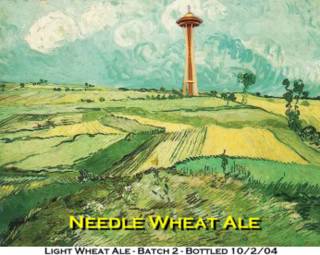Batch 11 - American Pale Ale
6 lbs Alexander's Pale Bulk Malt Syrup
1/2 lb English Crystal Malt, 40-50L
1/4 lb Dextrin Malt
1 1/2 Oz Perle Hops for boiling (I used 2)
1 Oz Cascade Hops for finishing (I used 2)
Wilamette and Kent Golding pelletized hops (~.5 oz each) in secondary
Same American Ale yeast used in the previous two batches
I started with a basic recipe for this batch, but added extra hops. I aerated using a shop vac. How this is done is placing the end of the shop vac to the lid of the brew bucket, where the airlock goes. Then turn on the vacuum and open the tap. Air is sucked through the tap and up through the beer, hopefully aerating.
Because this batch is quickly following my previous batch, I used trub (yeast castings from the bottom of the bucket) from that batch. I sanitized two bottles and filled them with trub. After aerating, I poured this on top of the batch.
I guess this combination of thourogh aeration and plentiful yeast worked better than I'd hoped. By the next morning (~12 hours later) this happened:

Overflow
The towel around the bucket is used with a heating pad to keep the beer a nice 70 degrees. As it's good practice to have your yeast work quickly, it's certainly worth a bit of cleanup to have such productive yeast. Next time I'll set up an overflow bowl.
Brewed: 1/29/05
Status: Bottled
1/2 lb English Crystal Malt, 40-50L
1/4 lb Dextrin Malt
1 1/2 Oz Perle Hops for boiling (I used 2)
1 Oz Cascade Hops for finishing (I used 2)
Wilamette and Kent Golding pelletized hops (~.5 oz each) in secondary
Same American Ale yeast used in the previous two batches
I started with a basic recipe for this batch, but added extra hops. I aerated using a shop vac. How this is done is placing the end of the shop vac to the lid of the brew bucket, where the airlock goes. Then turn on the vacuum and open the tap. Air is sucked through the tap and up through the beer, hopefully aerating.
Because this batch is quickly following my previous batch, I used trub (yeast castings from the bottom of the bucket) from that batch. I sanitized two bottles and filled them with trub. After aerating, I poured this on top of the batch.
I guess this combination of thourogh aeration and plentiful yeast worked better than I'd hoped. By the next morning (~12 hours later) this happened:

Overflow
The towel around the bucket is used with a heating pad to keep the beer a nice 70 degrees. As it's good practice to have your yeast work quickly, it's certainly worth a bit of cleanup to have such productive yeast. Next time I'll set up an overflow bowl.
Brewed: 1/29/05
Status: Bottled

